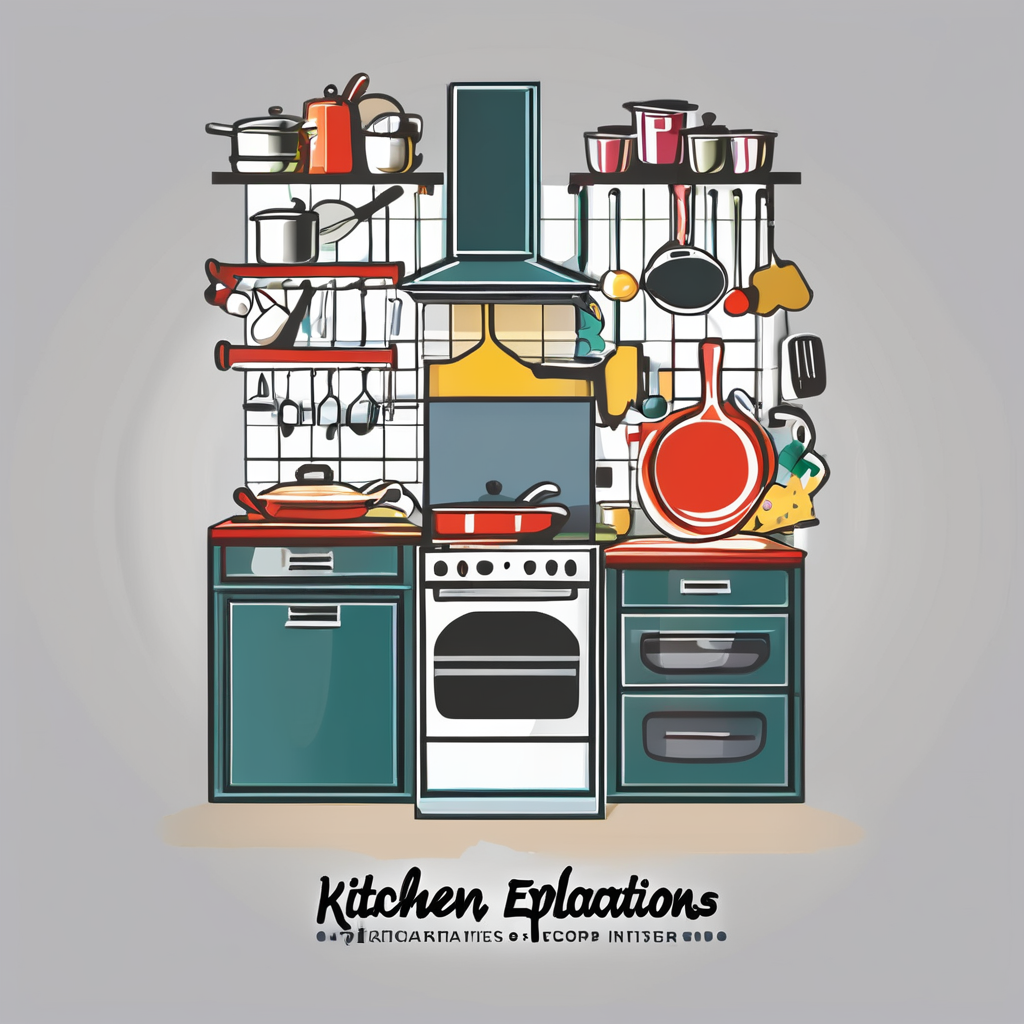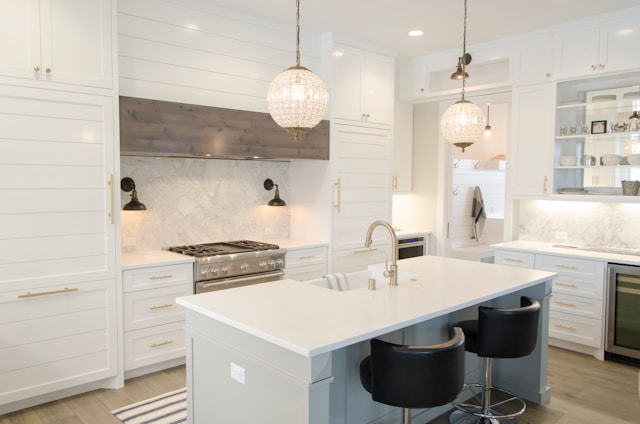Revamping your kitchen is an exciting venture, but the right lighting can make or break the aesthetic. Energy-efficient lighting not only enhances the ambiance but also significantly reduces your electricity bills. Discover how to combine functionality with style, implementing smart solutions like LED fixtures and dimmer switches. Transform your kitchen into an inviting space while being kind to the environment—your wallet and future sustainability depend on it!
Understanding Energy-Efficient Lighting
Incorporating energy-efficient lighting into your kitchen renovation can significantly enhance both functionality and sustainability. With a variety of options available, selecting the right lighting can transform your kitchen into an eco-friendly space.
Also read : Unlocking Space: Innovative Tips to Optimize Counter Area in Your Cozy Kitchen
LED bulbs are a popular choice, offering a lifespan that far exceeds traditional bulbs, reducing the need for frequent replacements. They consume less energy, making them a cost-effective solution. Compact Fluorescent Lamps (CFLs) are another option, known for their energy-saving capabilities and affordability. Both options contribute to a more sustainable kitchen design, aligning with modern environmental goals.
The importance of energy efficiency in kitchen design cannot be overstated. By reducing energy consumption, you not only lower your utility bills but also decrease your carbon footprint. This aligns with a growing trend towards sustainability in home renovations, making your kitchen both stylish and responsible.
Also read : Transform Your Galley Kitchen: Leveraging Mirrors to Create an Illusion of Spaciousness
Choosing sustainable lighting has long-term benefits. It enhances the ambiance of your kitchen while promoting environmental responsibility. Moreover, energy-efficient lighting options often come with smart technology, allowing you to control lighting levels and further optimise energy use. Embracing these solutions is a step towards a more sustainable future.
Types of Energy-Efficient Lighting
When exploring energy-efficient lighting options for your kitchen, understanding the differences between LED lighting, CFL bulbs, and traditional incandescent bulbs is crucial. Each type offers distinct benefits and applications, making them suitable for various kitchen areas.
LED lighting is highly efficient, consuming significantly less energy than incandescent bulbs. They are ideal for task lighting, such as under-cabinet lights, due to their directional nature and bright illumination. Additionally, LED lights have a longer lifespan, reducing maintenance and replacement costs.
CFL bulbs, while not as long-lasting as LEDs, are still a viable option for ambient lighting. They offer a warm glow, suitable for creating a cosy atmosphere in dining areas. However, they contain small amounts of mercury, necessitating careful disposal.
In contrast, incandescent bulbs are less energy-efficient and have a shorter lifespan, making them less favourable for sustainable designs. They are, however, known for their warm light, which can enhance kitchen ambiance when strategically used.
The impact of light temperature on kitchen ambiance is significant. Warmer light temperatures create a welcoming environment, while cooler temperatures are better for focused tasks. Selecting the appropriate lighting type and temperature can transform your kitchen’s functionality and aesthetic appeal.
Lighting Layout and Design Ideas
Incorporating a well-thought-out kitchen lighting design can elevate the overall aesthetic and functionality of your space. A strategic lighting layout involves layering different types of light to meet various needs and enhance the ambiance.
Layering light is crucial; it includes ambient, task, and accent lighting. Ambient lighting provides general illumination, often achieved through ceiling fixtures or recessed lights. Task lighting focuses on areas where specific activities occur, like countertops or the sink, using under-cabinet lights or pendant fixtures. Accent lighting highlights architectural features or decorative elements, adding depth and interest.
Explore creative ideas for incorporating lighting fixtures that blend style and functionality. Consider using statement pendants above the kitchen island or integrating LED strips under cabinets for a modern touch. Mixing different styles and materials can also create a unique and personalised look.
Maximising natural light is another essential aspect of a successful lighting layout. Position mirrors or reflective surfaces to bounce daylight around the room. Combine this with artificial lighting to maintain brightness throughout the day. Thoughtful placement of windows and skylights can further enhance the natural light flow, creating a welcoming and energy-efficient kitchen environment.
Product Recommendations
When selecting the best energy-efficient bulbs for your kitchen, consider top-rated lighting fixtures that enhance both style and sustainability. Understanding the features and benefits of these products can guide you in making an informed choice.
Top-rated energy-efficient light fixtures include a variety of designs and functionalities to suit different kitchen needs. From sleek, modern pendants to versatile under-cabinet lights, these fixtures are designed to maximise illumination while minimising energy consumption.
Recommended brands for LED options include Philips and Cree, known for their high-quality, long-lasting bulbs. For CFL options, brands like GE and Sylvania offer reliable and affordable choices. These brands provide a range of products that cater to various lighting styles and preferences.
When choosing lighting, consider product features such as dimmability, colour temperature, and smart technology compatibility. Dimmable bulbs allow you to adjust light levels according to your needs, while smart bulbs offer the convenience of remote control and automation. Additionally, selecting bulbs with the right colour temperature can significantly impact your kitchen’s ambiance, making it either warm and inviting or bright and functional.
By focusing on these features, you can select lighting solutions that not only enhance your kitchen’s aesthetic but also contribute to a more sustainable living environment.
Installation Advice
When considering lighting installation for your kitchen, it’s crucial to weigh the options between DIY tips and hiring a professional. For those with basic electrical skills, DIY installation can be a rewarding project. Begin by ensuring you have the necessary tools: a voltage tester, wire strippers, and screwdrivers. Always turn off the power at the circuit breaker before starting any electrical work to ensure safety.
For straightforward tasks like replacing energy-efficient bulbs or installing plug-in fixtures, DIY is often feasible. However, if your project involves complex wiring or new circuit installations, it’s advisable to hire a professional. Professional installation guarantees compliance with electrical codes and ensures the longevity of your lighting system.
Safety is paramount during installation. Use a ladder with caution and wear rubber-soled shoes to prevent slips. If you encounter any unexpected issues, such as faulty wiring or outdated circuits, consult a professional immediately. They can provide the expertise needed to tackle these challenges safely.
Consider the benefits of professional installation, especially for integrated systems or smart lighting setups. Professionals can offer insights into optimal fixture placement, enhancing both the functionality and ambiance of your kitchen.
Cost Savings and Incentives
Investing in energy-efficient lighting for your kitchen can lead to substantial cost reduction over time. The initial investment in LED or CFL bulbs may be higher, but the long-term energy savings are significant. By consuming less electricity, these lighting options can lower your utility bills substantially. For instance, replacing traditional incandescent bulbs with LEDs can result in up to an 80% reduction in energy consumption.
In addition to direct savings, various incentives are available to encourage energy-efficient upgrades. Many utility companies offer rebates for purchasing and installing energy-efficient lighting. These rebates can offset the initial costs, making the transition more affordable. It’s advisable to check with local energy providers for specific rebate programs and eligibility criteria.
The financial benefits extend beyond immediate savings. Energy-efficient lighting fixtures have a longer lifespan, reducing the frequency and cost of replacements. This longevity further contributes to cost reduction over time. Moreover, investing in energy-efficient solutions can increase your home’s resale value, as potential buyers often seek sustainable and cost-effective features. Embracing these lighting options not only supports environmental goals but also provides tangible financial advantages.
Maintenance and Upkeep
Proper lighting maintenance is essential to ensure the longevity and optimal performance of your energy-efficient light fixtures. By following some simple upkeep tips, you can extend the lifespan of your lighting and avoid common issues.
Regular cleaning is a fundamental part of lighting maintenance. Dust and grime can accumulate on bulbs and fixtures, reducing their brightness and efficiency. Use a soft cloth or a duster to gently clean surfaces, ensuring that the lights are turned off and cool to the touch.
Understanding the lifespan of different lighting types is crucial. LED bulbs, for instance, can last up to 25,000 hours, while CFLs have a shorter lifespan of around 8,000 hours. Knowing when to replace these bulbs prevents unexpected outages and maintains consistent lighting quality.
Troubleshooting common lighting issues involves checking connections and ensuring that fixtures are properly installed. If a bulb flickers, it might be due to a loose connection or an incompatible dimmer switch. Always consult the manufacturer’s guidelines or a professional if issues persist.
By implementing these upkeep tips, you can maintain efficient lighting in your kitchen, ensuring both functionality and sustainability for years to come.
The Role of Smart Technology
Incorporating smart lighting into your kitchen design can revolutionise how you manage energy and enhance your home’s functionality. Smart lighting solutions offer advanced home automation, allowing you to control lighting levels with ease. This integration not only adds convenience but also optimises energy use through intelligent energy management systems.
Smart lighting can be programmed to adjust automatically based on your daily routines. For example, lights can dim during the day when natural light is abundant, reducing energy consumption. This adaptability contributes to significant cost savings over time, aligning with sustainable living goals.
The benefits of smart lighting extend beyond energy savings. They enhance kitchen ambiance by offering customisable lighting scenes for different occasions, whether it’s a cosy dinner or a lively gathering. Furthermore, smart lighting systems often integrate with other home automation devices, providing seamless control through apps or voice commands.
Investing in smart lighting technology is a forward-thinking approach to kitchen design. It not only supports efficient energy management but also elevates your kitchen’s functionality and aesthetic appeal. Embracing this technology is a step towards a more connected and sustainable home environment.
Case Studies and Success Stories
Exploring kitchen renovation examples provides valuable insights into the transformative power of energy-efficient lighting. These real-life case studies highlight the practical benefits and aesthetic enhancements achieved through thoughtful lighting choices.
One homeowner, Jane, shared her journey of integrating energy-efficient lighting during her kitchen renovation. Opting for LED under-cabinet lights and smart dimmable fixtures, Jane noted significant reductions in her energy bills. The improved illumination also enhanced her kitchen’s functionality, especially during evening cooking sessions.
Another success story comes from Mark, who embraced a sustainable approach by incorporating CFLs and strategically placed skylights. His renovation not only improved the kitchen’s ambiance but also maximised natural light, reducing the need for artificial lighting during the day.
Lessons learned from these projects emphasise the importance of planning and selecting the right lighting solutions. Homeowners discovered that investing in quality fixtures and consulting with experts can lead to both immediate and long-term benefits.
These success stories underscore the potential of energy-efficient lighting to revolutionise kitchen spaces, demonstrating that with the right approach, functionality and sustainability can seamlessly coexist.
Future Trends in Kitchen Lighting
Exploring the future of kitchen design reveals exciting lighting trends poised to transform our culinary spaces. As technology advances, the integration of innovative lighting solutions becomes increasingly prominent.
One emerging trend is the use of smart lighting systems. These systems allow homeowners to personalise lighting settings, adjusting brightness and colour to suit different moods and activities. This not only enhances ambiance but also optimises energy efficiency.
Another trend involves human-centric lighting, which adapts to our natural circadian rhythms. By mimicking natural daylight patterns, these systems can improve mood and productivity, making kitchens more inviting and functional spaces.
The future of kitchen lighting design also includes OLED technology. Organic Light Emitting Diodes offer flexibility in design, allowing for ultra-thin, bendable panels that can be seamlessly integrated into various surfaces. This innovation opens up new possibilities for creative and unobtrusive lighting solutions.
Predictions suggest that sustainable materials will become a focal point in lighting design. The use of recycled and eco-friendly materials aligns with the growing emphasis on sustainability in home renovations. These advancements promise to make kitchens not only more aesthetically pleasing but also more environmentally conscious.






